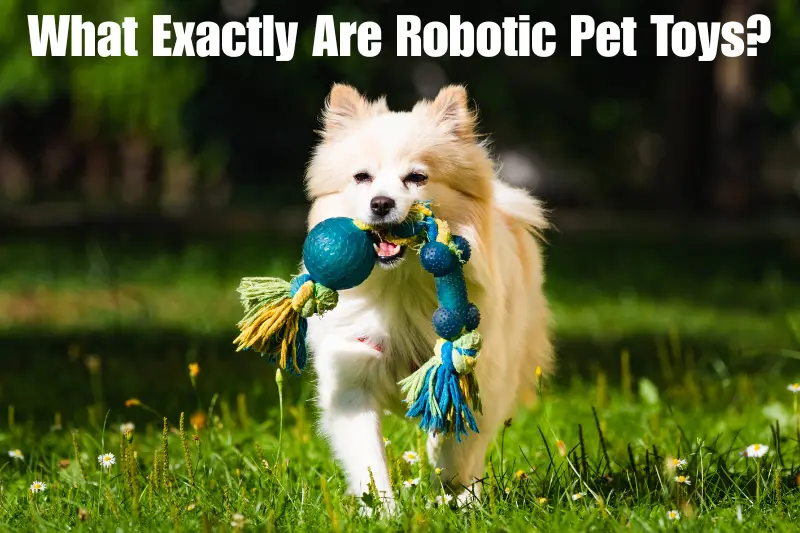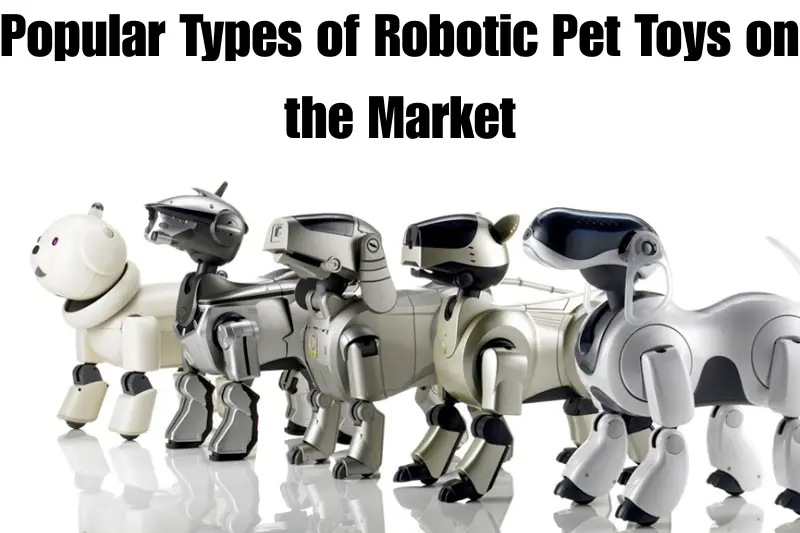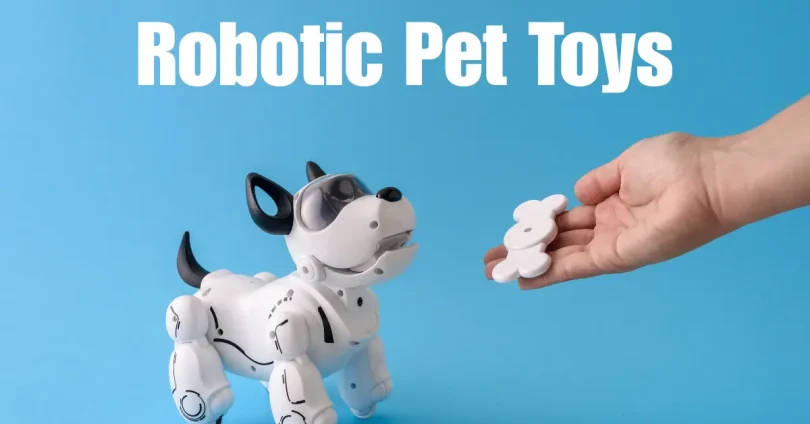If you’ve ever wished your pet could entertain themselves safely while you’re busy or away, then robotic pet toys might just be the perfect solution you didn’t know you needed. These clever gadgets combine technology, creativity, and pet care to create a whole new way for pets and owners to interact and have fun.
In this article, we’ll explore what robotic pet toys are, why they are rapidly growing in popularity, what benefits they offer, and what to look for when choosing one for your furry friend.
What Exactly Are Robotic Pet Toys?

Robotic pet toys are essentially interactive gadgets designed to engage and entertain pets through a variety of movements, sounds, and sometimes even AI-powered responses. Unlike traditional pet toys—like chew bones or tennis balls—robotic pet toys can mimic the unpredictable actions of real animals or playmates, stimulating your pet’s mind and body.
These toys come in many forms:
- Moving toys that roll or scurry across the floor, enticing pets to chase.
- Fetch machines that throw balls or other objects automatically.
- Puzzle robots that dispense treats when pets solve a challenge.
- Interactive companions that respond to your pet’s movements or vocalizations.
Thanks to advancements in artificial intelligence and machine learning, many robotic pet toys can now “learn” from your pet’s behavior and adjust their actions, making playtime more engaging and less repetitive.
Why Are Robotic Pet Toys Becoming So Popular?
The market for robotic pet toys is booming. In 2023, it was valued at approximately USD 2.5 billion worldwide and is expected to grow to about USD 6.8 billion by 2032—that’s almost triple in less than a decade! This rapid growth is driven by several exciting factors:
1. Increasing Pet Ownership
Around the world, pet ownership is on the rise. Many people now consider pets like dogs and cats as full-fledged family members. This shift has led to a significant increase in spending on pet care products that improve their pets’ quality of life. Robotic pet toys fit perfectly into this trend because they offer both entertainment and mental enrichment, something that traditional toys often lack.
2. Technological Advancements
The development of smarter, more interactive toys is fueled by breakthroughs in AI, machine learning, and robotics. These technologies allow toys to respond dynamically to pets’ actions, recognize their patterns, and even “play” with them in a way that mimics real interactions. This level of sophistication makes robotic pet toys especially attractive to pet parents who want more than just a basic chew toy.
3. Busy Lifestyles
In today’s fast-paced world, many pet owners find it challenging to spend as much time playing with their pets as they’d like. Robotic pet toys offer a practical solution by keeping pets engaged and active when their owners are working, running errands, or otherwise occupied. This helps reduce boredom and anxiety in pets, which can lead to destructive behaviors if left unaddressed.
4. Integration with Smart Homes and IoT
With the rise of smart homes, robotic pet toys are increasingly designed to integrate seamlessly with Internet of Things (IoT) devices. This means you can control, monitor, and schedule playtime remotely through your smartphone or other connected devices. Imagine setting your pet’s toy to start a game when you leave the house or checking in to see how your pet is interacting with their robotic friend!
5. Appeal to Millennials and Gen Z
Younger generations, especially Millennials and Gen Z, are known for their affinity for technology. They are driving the demand for innovative pet care products that combine tech with everyday life. These groups often seek out smarter, interactive solutions that align with their tech-forward lifestyles, making robotic pet toys a natural fit.
You may also like to read this:
AI Technology For Pets: Benefits And Latest Trends 2025
Top Benefits Of Automated Pet Care Systems For Busy Owners
Best Smart Pet Feeders with AI For Healthy Pets 2025
Best Pet Monitoring AI Cameras For Remote Pet Care In 2025
The Benefits of Robotic Pet Toys for Your Pets
Now that we understand why robotic pet toys are trending, let’s talk about how they actually benefit your pets:
Mental Stimulation
Pets, especially dogs and cats, need mental challenges to stay sharp and happy. Robotic toys provide unpredictable movements and interactive play that stimulate your pet’s brain. This helps reduce boredom and can even improve problem-solving skills in some pets.
Physical Exercise
Many robotic toys encourage pets to run, jump, or chase—activities that promote healthy exercise. For pets that don’t get enough outdoor play, these toys can be a great way to help them burn off energy indoors.
Reduced Anxiety and Loneliness
Pets left alone for extended periods often experience separation anxiety or boredom, leading to destructive behaviors like chewing furniture or excessive barking. Robotic pet toys offer companionship and engagement, helping to ease these issues by keeping your pet entertained.
Convenience for Pet Parents
Robotic pet toys are designed to make life easier for busy pet owners. By keeping pets entertained and mentally active, these toys can reduce the guilt and stress owners sometimes feel when they can’t dedicate enough time to play.
What Should You Look for in a Robotic Pet Toy?
If you’re considering investing in a robotic pet toy, here are some important factors to keep in mind:
- Pet Size and Play Style: Make sure the toy is suitable for your pet’s size and energy level. A small robotic toy might not be durable enough for a large dog who loves to chew.
- Durability and Safety: Look for toys made with pet-safe materials that can withstand rough play. Avoid toys with small parts that could pose a choking hazard.
- Battery Life and Charging: Some robotic toys run for hours on a single charge, while others need frequent recharging. Choose one that fits your lifestyle.
- Interactive Features: More advanced toys use AI and sensors to adapt to your pet’s play habits. Decide how “smart” you want your pet’s toy to be.
- Ease of Cleaning: Pets can get messy! Toys that are easy to clean or waterproof will be more convenient in the long run.
How to Introduce Robotic Pet Toys to Your Pet
Introducing a robotic pet toy to your pet might take a little patience, especially if they’re used to traditional toys. Here are some tips to help make the transition smooth and fun:
1. Start Slow
Let your pet get familiar with the robotic toy while it’s turned off. Let them sniff it, paw at it gently, and explore it at their own pace. This helps reduce any initial fear or hesitation.
2. Use Positive Reinforcement
When you first activate the toy, reward your pet with treats or praise when they show interest or interact with it. This creates a positive association with the toy.
3. Supervise Initial Play Sessions
For the first few times, watch your pet play with the robotic toy to ensure they’re safe and comfortable. This also gives you the chance to adjust the toy’s settings or behavior based on your pet’s reactions.
4. Be Patient
Some pets take longer to warm up to new toys, especially if they’re high-tech and behave differently from what they’re used to. Keep trying, and don’t force interactions.
5. Rotate Toys
To keep things fresh, rotate the robotic toy with other favorite toys. This prevents boredom and keeps your pet’s interest alive.
Popular Types of Robotic Pet Toys on the Market

Curious about what robotic pet toys are out there? Here’s a quick overview of some popular categories and examples:
1. Interactive Ball Launchers
Devices like the iFetch or PetSafe Automatic Ball Launcher are perfect for dogs who love to play fetch. These machines throw balls at different distances, letting your dog exercise even when you’re busy.
2. Chase and Move Toys
Robots such as the VARRAM Pet Fitness Robot or Hexbug Nano Robotic Creatures move unpredictably, encouraging cats and dogs to chase and pounce.
3. Treat-Dispensing Robots
Toys like the Wickedbone Smart Bone or Furbo Dog Camera combine movement with treat dispensing, motivating your pet to interact and play for rewards.
4. Puzzle Robots
These toys challenge your pet to solve problems to earn treats, combining mental stimulation with physical activity. Examples include the Petcube Bites and CleverPet Hub.
Maintenance Tips for Your Robotic Pet Toy
Like any gadget, robotic pet toys require some care to keep them working well and safe for your pet. Here are a few simple maintenance tips:
1. Regular Cleaning
Pets can be messy, so wipe down the toy regularly to remove dirt, saliva, and dust. Use a damp cloth and mild soap if needed, but avoid submerging the toy in water unless it’s waterproof.
2. Check for Wear and Tear
Inspect your robotic toy often for any loose parts, cracks, or damage that could harm your pet or affect the toy’s function. Replace or repair parts as needed.
3. Battery Care
Follow manufacturer guidelines on charging. Avoid overcharging or letting the battery drain completely if the toy uses rechargeable batteries. For battery-operated toys, keep spare batteries handy.
4. Software Updates
If your robotic pet toy is app-connected or smart-enabled, keep the software or firmware updated. Updates can improve performance, add features, and fix bugs.
How to Choose the Perfect Robotic Pet Toy for Your Pet
Every pet is unique, so here are some pointers to help you decide which robotic pet toy suits your furry friend best:
- For Energetic Dogs: Look for toys that encourage running and fetching, like automatic ball launchers or chase bots.
- For Curious Cats: Choose toys that mimic small moving creatures or puzzle feeders that stimulate hunting instincts.
- For Anxious Pets: Interactive companions or treat-dispensing toys can provide comfort and distraction.
- For Senior Pets: Opt for gentler, slower-moving toys that encourage light activity and mental engagement without overwhelming them.
- For Busy Owners: Select toys with programmable features or remote controls so you can manage playtime from anywhere.
The Future of Robotic Pet Toys: What’s Next?
As technology evolves, so will robotic pet toys. Here’s what we can look forward to:
- More Personalization: AI will better learn your pet’s preferences and moods, tailoring playtime accordingly.
- Health Monitoring: Toys may track vital signs, activity levels, and even detect signs of illness or stress.
- Virtual Interaction: Imagine toys connected to apps that let you “play” with your pet remotely, speak to them, or reward them with treats even when you’re not home.
- Eco-Friendly Designs: Sustainable materials and energy-efficient tech will make these toys better for the planet.
- Multi-Pet Integration: Systems that manage interaction among multiple pets, ensuring everyone gets their fair share of fun.
Conclusion
Robotic pet toys are changing the game for pet care, offering fun, mental stimulation, and exercise—even when you’re not home. With features like AI, treat dispensing, and remote control, they keep pets engaged and ease owners’ busy lifestyles.
As technology advances, expect smarter, more personalized, and eco-friendly toys that do even more—from monitoring health to enabling virtual play. If you want a happier, healthier pet, investing in a robotic toy could be the smartest move yet.
FAQs
1. Are robotic pet toys safe for all pets?
Yes, most robotic pet toys are designed with pet safety in mind. However, always check the manufacturer’s guidelines and choose a toy that matches your pet’s size, breed, and play style to avoid choking hazards or damage.
2. Do robotic pet toys work for both dogs and cats?
Absolutely. There are robotic toys made specifically for dogs, cats, or even both. Dogs often enjoy chase-and-fetch features, while cats are typically attracted to toys that mimic small prey with unpredictable movements.
3. Can robotic pet toys replace human interaction?
No. While they’re great for independent play and stimulation, robotic toys should supplement—not replace—quality time and bonding with your pet.
4. How long do robotic pet toys last?
With proper maintenance and depending on usage, high-quality robotic pet toys can last several months to years. Regular cleaning and battery care help extend their lifespan.
5. Are these toys good for pets with anxiety?
Yes. Robotic toys can help relieve anxiety, especially in pets who are home alone often. Look for toys that offer soothing interaction or treat dispensing to help distract and calm your pet.







